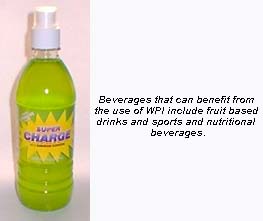Dry Whey Offers Beverage Formulators Alternative to Gum Arabic

By Bill Haines, Dairy Management Inc.
Stuck with "gum" in your beverage formulation? A product from the dairy industry may be able to get you out of a sticky situation.
Beverage formulators frustrated with the instability of gum arabic can now turn to a domestically available dry dairy ingredient to provide greater stability and economic advantages.
New research into the emulsification properties of whey protein isolate (WPI) shows that it provides the same functional characteristics of gum arabic, even when used in much lower concentrations in the formulation.

Responding to complaints from beverage formulators of "catastrophic failures" in gum arabic stability, D. Julian McClements, Ph.D., assistant professor in the Department of Food Science at the University of Massachusetts (Amherst, MA), tested an application of whey protein isolates in conditions commonly found in a fruit-style beverage system. His research, funded by America's dairy farmers and managed by Dairy Management Inc. (DMI), evolved into guidelines beverage manufacturers can follow to incorporate WPI into their formulations.
Alternative Emulsifier
McClements and his team used state-of-the-art rheological equipment to define environments when whey proteins would perform well. They discovered that combining a whey protein isolate with a sugar such as a polysaccharide, when heat-treated, maintains its liquid state, making it a viable alternative as an emulsifier in a beverage formulation.
In addition, whey protein can substitute for gum arabic because that gum, unique in its category, contains a protein in its makeup.
"By using a simple process, beverage manufacturers can take a commercially available WPI and treat it inside their own plant to modify it for their personal specifications," said McClements.
"Whey protein isolates offer beverage formulators several advantages. First, our research revealed that WPI can extend shelf-life up to one year," McClements said. "Second, manufacturers can realize a cost advantage. Gum arabic is more expensive than WPI. In addition, a formulator needs at least 20 times more gum arabic than whey protein to achieve the same effect."
In 1997, the latest year such figures are available, the United States imported 10.8 thousand metric tons of gum arabic, a surfactant commonly used as an emulsifier in citrus-flavored beverages such as fruit-style drinks, juice mixes and blends. The world's commercial supply of gum arabic, produced by African and Middle Eastern countries, can suffer adverse effects due to political unrest and climatic variability. In addition, seasonality, drought and soil conditions also affect the supply and quality of gum arabic.
Beverages Can Benefit
Dairy ingredients such as WPI offer a readily available, label friendly alternative to formulators who have turned to chemically modified starches or other synthetic ingredients in an attempt to find a solution to the dilemma posed by gum arabic.
The types of beverages that might benefit from the use of WPI could include infant formulas, fruit based drinks, and sports and nutritional beverages. Product extensions that require further study might involve use of WPI as an emulsifier in salad dressings or other food systems.
For more information about the guidelines developed for the use of WPI in beverage systems, call Dairy Management Inc. at 1-800-248-8829.
About the Author: Bill Haines is vice president of Business-to-Business Marketing for Dairy Management Inc. DMI is the domestic and international planning and management organization responsible for increasing demand for dairy products on behalf of America's dairy farmers. DMI manages the American Dairy Association, National Dairy Council and U.S. Dairy Export Council.
